Friction Class 8 Notes Science Chapter 9
Have you ever noticed how a car or a truck driver slows down their vehicle at a traffic signal? Even when riding your bicycle, you slow down by applying brakes when necessary. But have you ever wondered why a vehicle slows down when brakes are applied? In this Class 8 Science chapter on "Friction," we will explore the answers to these intriguing questions. Let's dive into the Chapter Notes and uncover the secrets of friction together.
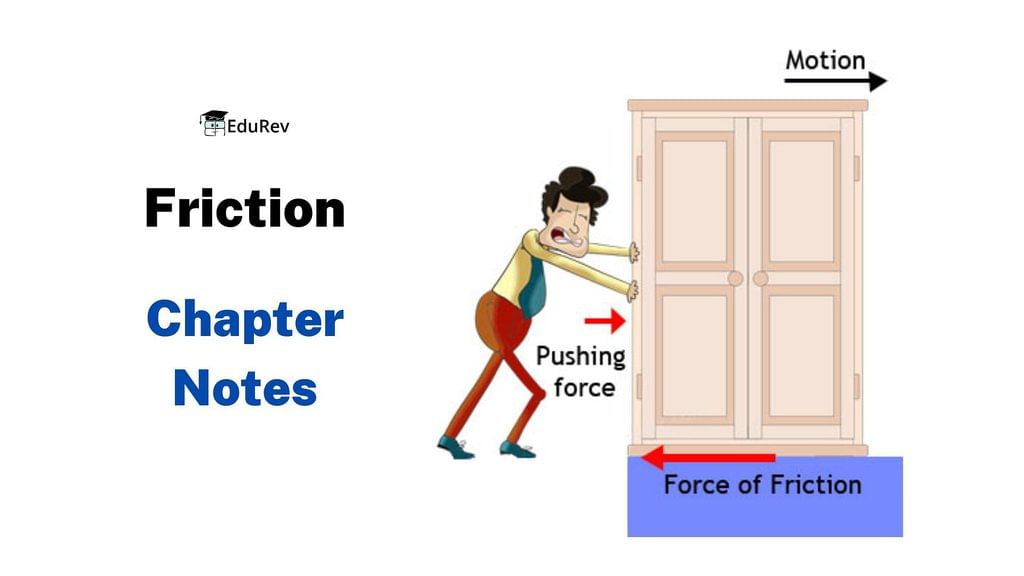
Force of Friction
Friction plays a crucial role in our daily lives as it is the force that opposes motion between surfaces in contact with each other.
- It can either work in our favor or against us, depending on the situation. For instance, when we sprinkle sand on an icy sidewalk, it increases friction, making it less likely for us to slip.
- However, excessive friction between moving parts in a car engine can lead to wear and tear.
Examples of Force of Friction:
(a) A moving wheel on the ground stops after covering a certain distance because surface of ground offers opposite direction friction to the surface of wheel in motion.
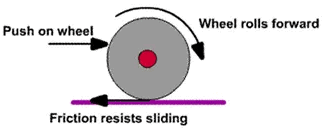 (b) After applying breaks to a moving bike, the surface of brakes offers friction to the surface of moving wheel and the bicycle stops because of force of friction.
(b) After applying breaks to a moving bike, the surface of brakes offers friction to the surface of moving wheel and the bicycle stops because of force of friction.
(c) Gently push a book on a table. It stops after moving for some distance because of friction between the surfaces of book and table.
Factors Affecting Friction
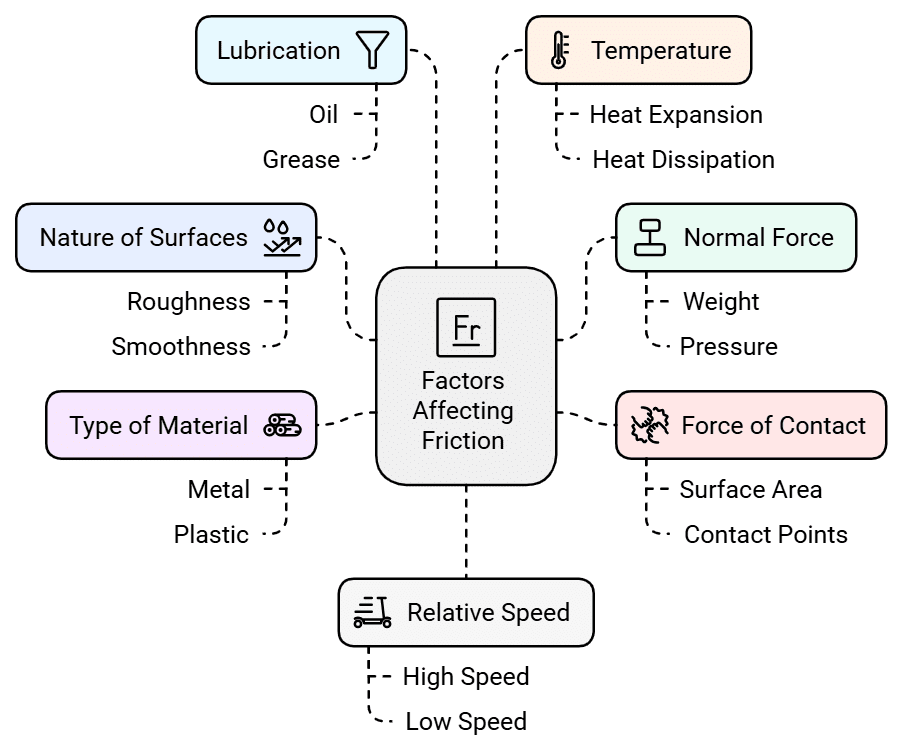 Friction is the force that opposes the motion of objects in contact with each other. It plays a significant role in our daily lives and affects the way objects move and interact. Several factors influence the amount of friction experienced between two surfaces.
Friction is the force that opposes the motion of objects in contact with each other. It plays a significant role in our daily lives and affects the way objects move and interact. Several factors influence the amount of friction experienced between two surfaces.

- Nature of Surfaces: The nature of the surfaces in contact determines the amount of friction. Rough surfaces generate more friction compared to smooth surfaces. Irregularities and bumps on the surfaces interlock and create more resistance to motion, leading to higher friction. For example, walking on a rough road will create more friction than walking on a polished floor.
- Normal Force: The normal force is the force exerted by a surface perpendicular to the contact area. The frictional force is directly proportional to the normal force. Increasing the normal force increases the frictional force. For instance, pushing an object harder against a surface increases the friction between them.
- Force of Contact: The force applied to overcome friction affects the magnitude of friction. When the force of contact between two objects is increased, the frictional force also increases. If you push a heavy object, you will experience greater friction than when you push a lighter object with the same force.
- Type of Material: The type of material in contact affects the frictional force. Different materials have different surface textures and interactions, resulting in varying amounts of friction. For example, rubber has a higher coefficient of friction on most surfaces than plastic or metal.
- Lubrication: The presence of lubricants, such as oil or grease, between two surfaces reduces friction. Lubricants form a thin layer that separates the surfaces, minimizing the contact and allowing smooth movement. This is why machines, engines, and vehicles often require lubrication to reduce friction and enhance efficiency.
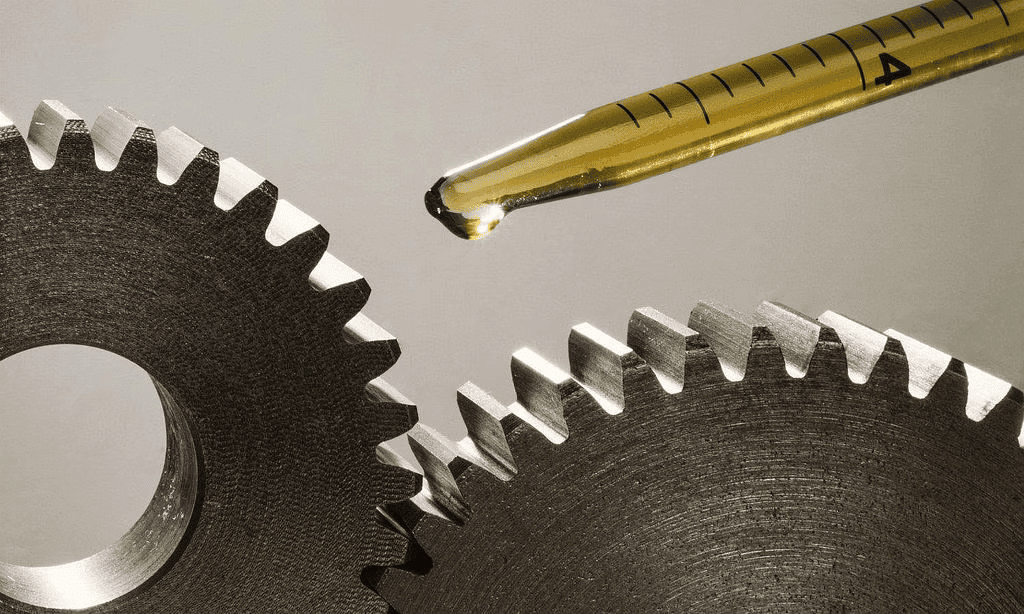 Lubrication Reduces Friction
Lubrication Reduces Friction - Temperature: Friction can be affected by temperature changes. In some cases, an increase in temperature can reduce friction, such as the use of lubricants that become more fluid at higher temperatures. However, in other cases, an increase in temperature can increase friction, like when two objects expand due to heat, leading to greater contact between them.
Relative Speed: The speed at which two surfaces move relative to each other can impact friction. Generally, the higher the relative speed, the greater the friction. For example, when driving a car at high speed, the friction between the tires and the road increases.
Friction: A Necessary Evil
Friction is an essential force that has both positive and negative effects. Let's explore some examples to understand why friction is considered a necessary evil:
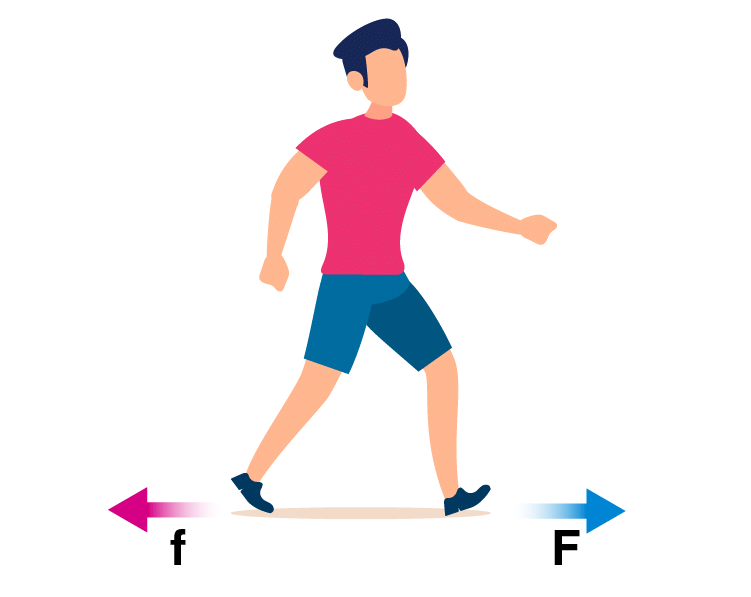
- Ease of Walking: Friction between our feet and the ground allows us to walk comfortably. Without friction, walking would become impossible as we would constantly slip and fall. Even the simple act of getting out of bed would be challenging without the necessary friction.
- Importance of Shoe Soles: The grooves on shoe soles provide increased friction with the ground, ensuring better grip while walking. Worn-out soles reduce the friction and can make walking slippery, emphasizing the need for proper shoe maintenance.
- Enhanced Traction for Vehicles: The treads on vehicle tires serve the purpose of improving grip and friction with the road surface. When these treads wear out, the tires need replacement to maintain adequate friction and ensure safe driving conditions.
- Heat Generation: Friction has the ability to generate heat. A simple demonstration involves rubbing your palms together vigorously for a few minutes, which will produce heat due to the friction between your hands.
- Writing with a Pen: Friction between the pen tip and the paper enables us to write. The paper's surface provides the necessary friction for the pen to leave marks and create legible writing.

- Energy Wastage in Machines: When machines operate, friction between their moving parts generates heat. This heat generation leads to a significant wastage of energy, reducing the efficiency of the machine. Minimizing friction through proper lubrication and maintenance helps mitigate this energy loss.
Increasing and Reducing Friction
Friction is the force that opposes the motion of objects in contact with each other. Sometimes we want to increase friction, while at other times we may want to reduce it. Let's explore how we can achieve both.
Increasing Friction
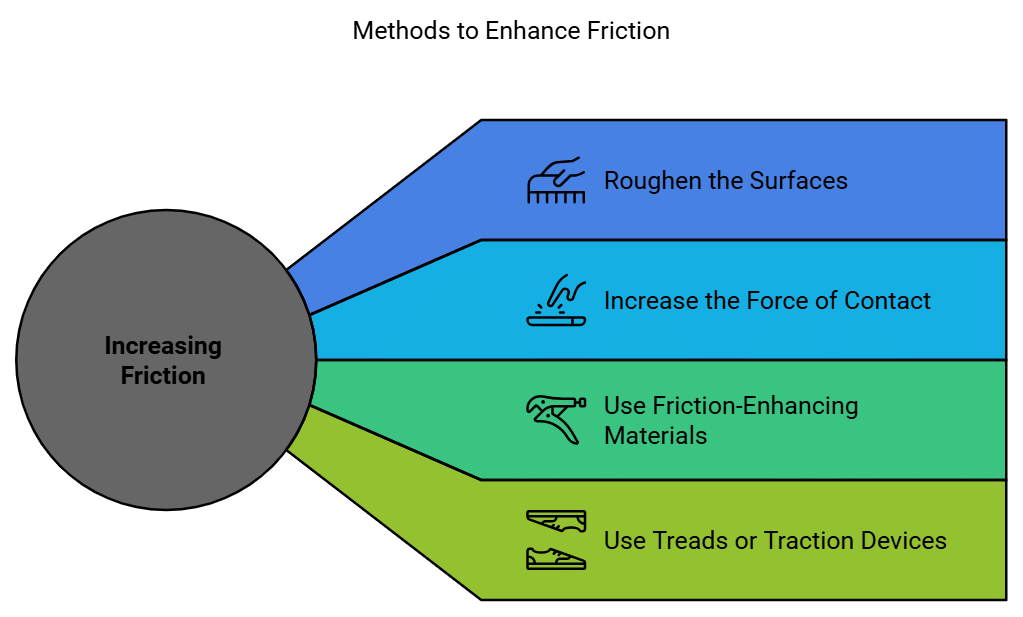
- Roughen the Surfaces: Rough surfaces have more bumps and irregularities, which increase friction. For example, adding grip tape to the handle of a tennis racket or using sandpaper on the soles of shoes can increase the friction and provide a better grip.
- Increase the Force of Contact: Increasing the force of contact between two surfaces increases the friction. For instance, pressing a book harder against a table while moving it will create more friction.
- Use Friction: Enhancing Materials: Certain materials, like rubber, have a higher coefficient of friction. Utilizing rubber mats or gloves can increase the friction between objects and improve grip.
- Use Treads or Traction Devices: Adding treads to tires or wearing shoes with anti-slip soles can increase friction and enhance traction. These treads provide more surface area in contact with the ground, increasing the frictional force.
Reducing Friction
- Smoothen the Surfaces: Smoothing or polishing surfaces can reduce friction. For example, using lubricants or polishing the surface of a wooden drawer can make it slide more smoothly.
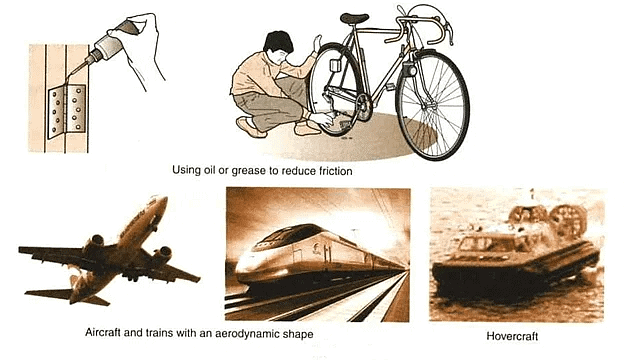 Reducing Friction
Reducing Friction
- Use Lubricants: Lubricants like oil, grease, or wax reduce friction by creating a thin layer between two surfaces. This layer reduces the direct contact, allowing objects to slide or move more easily. Lubricating door hinges or applying oil to bicycle chains are common examples.
- Streamline the Shape: Reducing the surface area in contact with the air can reduce friction with the surrounding medium. This principle is applied in designing streamlined shapes for vehicles like cars or bicycles, reducing air resistance and friction.
- Minimize Surface Roughness: By reducing the irregularities on surfaces, friction can be reduced. Using ball bearings in machinery or polishing the surface of a car can help minimize frictional resistance.
Remember, friction can be both beneficial and undesirable depending on the situation. Understanding how to increase or reduce friction allows us to control its effects and optimize our actions. By applying these techniques, you can effectively manage friction in various scenarios, making tasks easier, improving efficiency, and ensuring safety.
Wheels Reduce Friction
Unlike sliding or dragging, where surfaces come into direct contact and experience higher friction, wheels allow objects to roll. This rolling motion significantly reduces the frictional force between the wheel and the surface it moves on.
Friction and its Types
(1) Static Friction
Static friction acts on objects when they are resting on a surface. For example, if you are hiking in the woods, there is static friction between your shoes and the trail each time you put down your foot. Without this static friction, your feet would slip out from under you, making it difficult to walk. In fact, that’s exactly what happens if you try to walk on ice. That’s because ice is very slippery and offers very little friction.
 Static Friction
Static Friction
(2) Sliding Friction
Sliding friction is friction that acts on objects when they are sliding over a surface. Sliding friction is weaker than static friction. That’s why it’s easier to slide a piece of furniture over the floor after you start it moving than it is to get it moving in the first place. Sliding friction can be useful.
 Sliding Friction
Sliding Friction
(3) Rolling Friction
Rolling friction is friction that acts on objects when they are rolling over a surface. Rolling friction is much weaker than sliding friction or static friction. This explains why most forms of ground transportation use wheels, including bicycles, cars, 4-wheeler, roller skates, scooters, and skateboards.
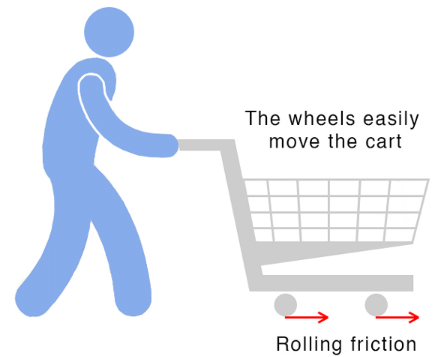
Fluid friction
Fluid friction is friction that acts on objects that are moving through a fluid. A fluid is a substance that can flow and take the shape of its container. Fluids include liquids and gases. If you’ve ever tried to push your open hand through the water in a tub or pool, then you’ve experienced fluid friction.
Objects which are made to move in fluid are made streamlined shape to reduce friction offered by fluid. The shape of aeroplane, ship, boat, birds and fish are made streamlined shape. A shape which is pointed on both ends and wide at the middle is called which facilitates easier movement through fluids. The frictional force offered by fluids is called drag.
 Fluid Friction
Fluid Friction
Frequently Asked Questions (FAQs) Related to Friction
1. What is friction?
Ans. Friction is a force that opposes the relative motion between two surfaces in contact. This force arises due to the irregularities present on the surfaces in contact. The magnitude of frictional force depends upon the nature of the surfaces in contact, the force pressing the surfaces together, and the roughness of the surfaces.
2. What are the types of friction?
Ans. The types of friction are static friction, kinetic friction, rolling friction, and fluid friction. Static friction is the force that opposes the start of motion. Kinetic friction is the force that opposes the motion of a body in contact with another body. Rolling friction is the force that opposes the rolling motion of a body over another body. Fluid friction is the force that opposes the motion of an object through a fluid medium.
3. How does friction affect the movement of objects?
Ans. Friction affects the movement of objects by opposing their motion. It acts in the direction opposite to the motion of the object. The greater the frictional force, the harder it is to move the object. However, friction also enables us to walk, drive vehicles, and use brakes to stop vehicles. Without friction, we would not be able to perform these tasks.
4. How can friction be reduced?
Ans. Friction can be reduced by using lubricants such as oil and grease on the surfaces in contact. Lubricants fill the gaps between the surfaces and reduce the roughness of the surfaces, thereby reducing friction. Smoothening the surfaces or using ball bearings can also reduce friction. Additionally, reducing the force pressing the surfaces together can reduce friction.
5. What are some real-life examples of friction?
Ans. Some real-life examples of friction are walking on the ground, driving a car, using brakes to stop a car, writing with a pen on paper, and rubbing hands together to generate heat. In all these examples, friction plays a crucial role. Without friction, it would be difficult to perform these activities.
|
92 videos|296 docs|44 tests
|
FAQs on Friction Class 8 Notes Science Chapter 9
| 1. What are the main factors affecting friction? |  |
| 2. What are the different types of friction? |  |
| 3. How do wheels reduce friction? |  |
| 4. Why is friction considered a "necessary evil"? |  |
| 5. How can friction be increased or reduced in different scenarios? |  |






















